- Tears are flowing this evening after my annual viewing of that guileless, lovable and wildly optimistic but unbelievably naive George Bailey (and that proud, mean, miserable, weasel-hearted, arrogant banker thief, Mr. Potter) in "It's A Wonderful Life," due not only to its traditional themes* of love, generosity and care for others added to the current reality that the script is being rewritten daily by the Pentagon, the defense-supplier companies, the influential rich like the Koch Brothers (compliments of PBS, NPR and all their other charities) and the Murdochiana NewsCorps, Inc.
Paul Craig Roberts asks us to turn our attention during this holiday season, which is traditionally overfilled with sentiment about sharing with the less fortunate and being generous to strangers, momentarily to this possibly terminal idea:
When Americans fell for the obviously false official 9/11 story, the black op inhumans realized that they can get away with anything. These murderers are enabled by the witless American public. Expect more such operations. They are all a part of Fear On Demand.
San Bernardino Incident Has the Earmarks of a False Flag. Testimony of Eyewitnesses
Three separate eyewitnesses saw three tall male caucasians carry out the executions.
Syed Rizwan and Tashfeen Malik were chosen to be the patsies and murdered so that they could not contradict the concocted accusation against them.
As long as insouciant, gullible Americans accept such implausible oficial stories as 9/11, the Boston Marathon Bombing, and the San Bernardino shootings, the American public will continue to be complicit in official US black op murders of innocent people.
Read (Stephen) Lendman’s report:
It was on Dec. 9, 2004, when the mean-spirited mainstream media’s treatment of investigative journalist Gary Webb led him – his career devastated, his family broken, his money gone and his life seemingly hopeless – to commit suicide. It was a moment that should have shamed all the big-shot journalists who had a hand in Webb’s destruction, but it mostly didn’t.
Webb’s offense was to have revived the shocking story of the Reagan administration’s tolerance of cocaine smuggling by the CIA-backed Nicaraguan Contra rebels in the 1980s. Though the scandal was real – and had been partly exposed in real time – the major newspapers had locked arms in defense of President Ronald Reagan and the CIA. The sordid scandal apparently was deemed “not good for the country,” so it was buried._ _ _ _ _ _ _
My "Associated Press" colleague, Brian Barger, and I had written the first story exposing the Contras’ involvement in cocaine smuggling in 1985, but our story was attacked by Reagan’s skillful propaganda team, which got "The New York Times" and other major news outlets to buy into the denials.
Later that decade, a gutsy investigation by then-Sen. John Kerry filled in some of the gaps showing how the Reagan administration’s collaboration with drug-tainted airlines and other parts of the Contras’ cocaine smuggling apparatus had functioned. But Kerry’s probe was also mocked by the major media. Sniffing out that conventional wisdom, Newsweek deemed Kerry “a randy conspiracy buff.”
Kerry’s brush with this near-political-death-experience over the Contra-cocaine scandal taught him some hard lessons about survival in Washington, which help explain why he was such a disappointing candidate during Election 2004 and why he has shown such timidity in challenging Official Washington’s “group thinks” as Secretary of State.
For both U.S. journalists and politicians, there was no upside to doing the hard work of exposing this kind of crime of state. [See Consortiumnews.com’s “What’s the Matter with John Kerry.”]
Same Stonewall
In 1996, Gary Webb encountered the same stonewall when he stumbled onto evidence showing that some of the Contra cocaine, after being smuggled into the United States, had flowed into the production of “crack” cocaine in Los Angeles and contributed to the “crack epidemic” of the 1980s.
When he published his findings in a series for the San Jose Mercury News, the major newspapers had a choice: either admit that they had slinked away from one of the biggest scandals of the 1980s or redouble their efforts to discredit the story and to destroy anyone who dared touch it. They went with option two.
In a tag-team pummeling of Gary Webb, The Washington Post, The New York Times and the Los Angeles Times all denounced Webb and decried his reporting. Soon, Webb’s editors at the Mercury News were feeling the heat and rather than back their reporter, they sought to salvage their own careers. They sold Webb out – and he was soon out of a job and unemployable in the mainstream media.
The bitter irony was that Webb’s reporting finally forced a relatively thorough and honest investigation by the CIA’s Inspector General Frederick Hitz, who concluded in 1998 that not only were the Contras involved in the drug trade from their start in 1980 and through the entire decade but that CIA officers were aware of the problem and helped cover it up, putting the goal of ousting Nicaragua’s Sandinista government ahead of blowing the whistle on these corrupt CIA clients.
Yet, even the CIA’s confession wasn’t enough to shame the major newspapers into admitting the truth and acknowledging their own culpability in the long-running cover-up. It remained easier to continue the demonization of Gary Webb.
At "Consortiumnews," we were one of the few news outlets that examined the extraordinary admissions contained in the CIA’s two-volume report and in a corresponding Justice Department Inspector General’s report, which added more details about how criminal investigations of the Contras were thwarted. But, sadly, we lacked the reach and the clout of the major newspapers.
As the controversy bubbled in 1996, I also had joined with Webb in several speaking engagements on the West Coast. Though we sometimes spoke to large and enthusiastic crowds, the power of the Big Media overwhelmed everything, especially the truth. [For details, see "Consortiumnews.com" ’s “The Sordid Contra-Cocaine Saga.”]
Webb’s Demise
In the years after the Contra-cocaine story was buried once again, I lost touch with Webb who had landed a job with a California state legislative committee. So, I didn’t realize that after that job ended, Webb’s life was spiraling downward. Even modest-sized newspapers refused to consider hiring the “disgraced” reporter.
Webb’s marriage fell apart; he struggled to pay child-support and other bills; he was faced with a forced move out of a house near Sacramento, California, and in with his mother. Deeply depressed, according to his family members, Webb chose to end his life.
On Dec. 9, 2004, the 49-year-old Webb typed out suicide notes to his ex-wife and his three children; laid out a certificate for his cremation; and taped a note on the door telling movers — who were coming the next morning — to instead call 911.
Webb then took out his father’s pistol and shot himself in the head. The first shot was not lethal, so he fired once more. (Yes, I know that conspiracy theorists have seized on the two shots to insist that Webb was murdered by the CIA, but there is no proof of that and by pushing that baseless account, people simply let the real culprits – the big newspapers – off the hook.)
After Webb’s body was found, I received a call from a reporter for the Los Angeles Times who knew that I was one of Webb’s few journalistic colleagues who had defended him and his work. I told the reporter that American history owed a great debt to Gary Webb because he had forced out important facts about Reagan-era crimes. But I added that the Los Angeles Times would be hard-pressed to write an honest obituary because the newspaper had essentially ignored Hitz’s final report, which had largely vindicated Webb.
To my disappointment but not my surprise, I was correct. The Los Angeles Times ran a mean-spirited obituary that made no mention of either my defense of Webb, nor the CIA’s admissions in 1998. The obituary was republished in other newspapers, including The Washington Post.
Even though Webb’s reputation posthumously received some rehabilitation with a sympathetic portrayal of his ordeal in Jeremy Renner’s 2014 movie, “Kill the Messenger,” some news executives who aided the Contra-cocaine cover-up in the 1980s and abetted the destruction of Webb in the 1990s still won’t admit their complicity in suppressing one of the most important stories of that era, people such as The Washington Post’s Jeff Leen and Leonard Downie. [See Consortiumnews.com’s “WPost’s Slimy Attack on Gary Webb and “How the Washington Press Turned Bad.”]
A few journalists have continued to find nuggets of the Contra-cocaine scandal, including from accounts by former CIA contract pilot Robert “Tosh” Plumlee, who supplied details about his work ferrying guns and drugs for Reagan’s Contras, as reported by John McPhaul of The Tico Times, based in San Jose, Costa Rica. Even Fox News poked into the Contra-cocaine connection in an article about alleged CIA complicity in the 1985 torture-murder of Drug Enforcement Administration agent Enrique “Kiki” Camarena.
But the resistance from the major U.S. news media and the ferocity from Reagan’s acolytes whenever their hero’s legacy is challenged have left this very real scandal in the netherworld of doubt and uncertainty, a key chapter of America’s Lost History in which Dec. 9, 2004, conveys a baleful message.
[As part of our end-of-year fund drive, "Consortiumnews" is offering a DVD of “Kill the Messenger” and a CD of Webb and Parry speaking about the Contra-cocaine scandal in 1996. For details on this special offer, click here.]
Investigative reporter Robert Parry broke many of the Iran-Contra stories for The Associated Press and Newsweek in the 1980s. You can buy his latest book, America’s Stolen Narrative, either in print here or as an e-book (from Amazon and barnesandnoble.com). You also can order Robert Parry’s trilogy on the Bush Family and its connections to various right-wing operatives for only $34. The trilogy includes America’s Stolen Narrative. For details on this offer, click here.
Comments:
Remember that making the world better begins with responsible action.
- The RSN Team
+14 # 2015-12-13 14:20
For me the media died with their reporting of Katrena. Rather reporting how many men, women, and children died due to Bush's inaction, they would only use the word "people". And they used the same photo of a semi-submerged, non-gender specific adult, rather then the photos of dead women, children and infants. Thus softening the affects of the bush/cheney administrations lack of humanity.+5 # 2015-12-13 15:11
At least it wasn't "some folks died".
+6 # 2015-12-13 15:08Everything must be paid for. We pay for our self-indulgence with poor health, for our desertion of optimism, objectivity, and integrity with cynicism, despair, and bigotry.
In this case, we let our government approve ownership of all our means of reporting - television, radio, newspaper - by a handful of buyers. Now the likes of Rupert Murdock controls what we can ask, what we can learn, whether we can make our voices heard by government in questions, complaints, or demands.
Put down your cell phone for all but an hour a day. Turn off your computer, laptop, television, and read a book; talk to someone, face to face; attend a meeting of some local body of government - a treat that I promise you will raise your blood pressure by at least ten points if you know enough to realize what is going on.
Meanwhile, reach for your checkbook or credit card and put some money in the hat for the independent news organizations who still are TRYING to bring us objective reports, to ferret out answers, to obtain proof - organiza tions like Reader Supported News.
RSN's staff of writers and support personel pay rent/mortgages, buy groceries, and have transportation expenses, just as we all do. Sleeping indoors and eating regularly requires a salary - AND WE ARE THE ONES WHO PAY THOSE SALARIES!
Everything must be paid for. Chip in $5.00 or $10.00 per month to help regain our government and keep freedom alive.
There is no free lunch, kiddies: pay your dues!
* . . . you have to know Frank Capra's own story to understand why the movie is so great. What makes his pictures unforgettable came from Capra himself - out of his own wonderful life, with its unquenchable optimism and his belief that "all will yet be well."
First Grand Slam. Frank was born in 1897 in Bisaquino, Sicily, and celebrated his sixth birthday in the hold of a ship crammed with immigrants bound for America. After 13 days aboard, his father carried him on deck and pointed to the Statue of Liberty in New York Harbor. "Look at that!" he shouted. "It's the light of freedom!" Frank never forgot that moment or what it meant to his family.
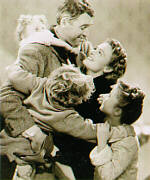
The Capras settled in Los Angeles, where Papa became a fruit picker and Mama a factory worker. Neither parent could read or write. But education, they decided, would be the key to success for the American Capras. So it was a momentous family occasion when Frank, after only three months in his new land, was chosen to lead his school in pledging allegiance to the flag - in English! That day Frank Capra discovered what would later become one of the most important themes of his movies: "One nation...with liberty and justice for all!"
Frank took jobs before and after school and still got grades good enough to get into California Institute of Technology. There he earned a degree in chemical engineering. He also waited tables and, along the way, taught himself to play guitar. When he graduated in 1918, America was fighting World War I.
With his engineering skills in demand, he might have had a draft exemption. But Frank enlisted in the Army and was assigned to teach mathematics to artillery officers in San Francisco. He ended the war with a severe case of influenza - and no job.
So he took his guitar and hopped freight trains to see America, singing for his supper. In December 1921, he was locked out of his San Francisco hotel room because he couldn't pay his $18 bill. A syndicate of bootleggers offered the young engineer $20,000 to design alcohol stills. Frank turned them down flat.
Then he saw a want ad. A movie production company needed an experienced director. "I'm from Hollywood," Frank fibbed. He got the job - and later, ashamed, would apologize for lying.
Over the next decade, he made 22 films. He hit Hollywood's first grand slam in 1934 with a simple story of a spoiled rich girl who learns to appreciate ordinary people. "It Happened One Night" won the five top Academy Awards - a record that remained unbroken for 41 years!
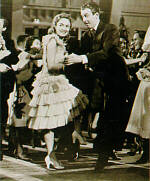
True Riches. By age 40, after he had won his second best-director Oscar, for "Mr. Deeds Goes to Town," he was King of Hollywood. But Frank was no high-liver. When he wasn't shooting films, he was usually home with his wife, Lucille, and their three kids. They were so happy Frank made up his own bedtime prayer: "Lord, help us all to be good and kind, and give us peace in our house and in all other houses."
I was wonderfully impressed by Frank's pictures. But we didn't know each other until he sought me out for the 1938 comedy "You Can't Take It With You." I played a rich boy who wants to marry a poor girl. Jean Arthur played my fiancée, and her Grandpa Vanderhof was played by that marvelous actor Lionel Barrymore. Lionel expressed Frank's contempt for people who value money and position over kindness and love for one's fellow man.
That film reflected two of Frank's strongest beliefs: "Love thy neighbor" and "The meek shall inherit the earth." Without preaching, his films showed that life's true riches lie in family, country and God.
Frank had watched fascism conquer Europe and worried about fascists trying to get power in America. "I'm a silly goose about things patriotic," he once wrote. He enlisted in the Army in 1941 and was asked to make documentary films. His "Why We Fight" series became a part of the military training of every member of the armed forces. Gen. George Marshall personally pinned the Distinguished Service Medal on Frank for making those films. Afterward, Frank went into the first washroom he could find, locked a cubicle door behind him and cried like a baby.
Tale of a Lifetime. When Frank returned from the war, RKO studios handed him a short story called "The Greatest Gift," by Philip Van Doren Stern.
"Wow!" said Frank when he read it. "That's the story I've been looking for all my life."
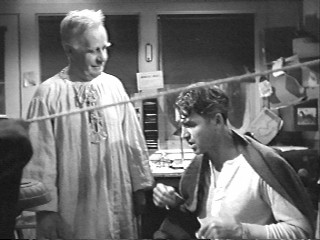
Frank came to see me and started telling me about it: "Now, you're in a small town," Frank said, "and things aren't going well - and you begin to wish you'd never been born. You decide to commit suicide by jumping off a bridge into a river - and an angel named Clarence comes down from heaven - and Clarence hasn't won his wings yet, you see. But he comes down to save you by jumping into the river. But Clarence can't swim, so you save him."
And then Frank stopped dead. He said, "This - this story doesn't tell very well, does it?"
Well, I just said, "Frank, if you want to do a movie about me committing suicide with an angel with no wings named Clarence, I'm your man."
Frank had never worked on a story that meant so much to him. He changed the name to It's a Wonderful Life, and we started to shoot it in the spring of 1946.
Whenever Frank thought he had made a mistake, he'd go to great lengths to fix it. I remember the day we shot the scene where George Bailey, the film's main character and the part I played, having apparently misplaced $8000, huddles at Martini's Bar and asks God for help. "Dear Father in Heaven," I say, "I'm not a praying man, but if you're up there and you can hear me, show me the way."
In the middle of praying, I was overcome with emotion and started to cry. Frank didn't know I was going to cry, you see. And neither did I. Afterward, Frank said, "I think I made a mistake, Jim. The camera was too far away when you cried. Do you think you could do it once more?" But because the emotion had been spontaneous, I didn't think I could do it over again.
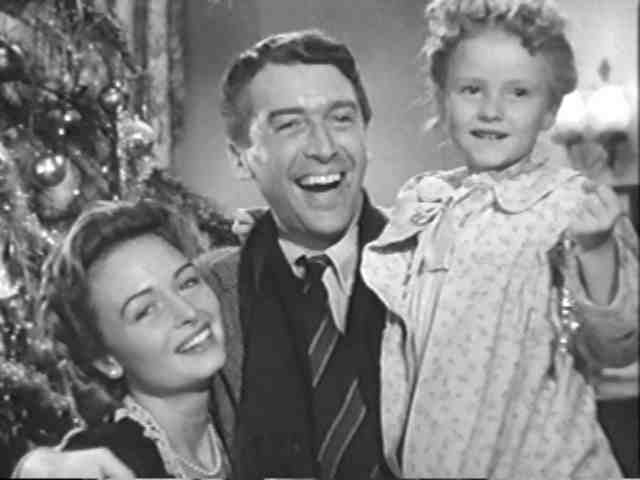
Frank said nothing more about it. But he stayed up that whole night enlarging every single frame of that scene - maybe 200 feet of film - on an optical printer. So when you see that close-up of me crying, it's not the camera moving in - it's a cut-in to that
painstakingly enlarged footage.
"My Memorial." One of the film's most memorable scenes is of family and friends gathering around the Bailey Christmas tree, helping George out by replacing the missing money. When we finished the picture, Frank expressed his hope that "it'll be a film that says to those who can't afford more education, or lose their job, or take radiation treatments, 'You are the salt of the earth, and "It's a Wonderful Life" is my memorial to you. No man is poor who has one friend. Three friends and you're filthy rich!' "
The sad thing, as I said, was that right after the war people didn't want this story. They just wanted wild slapstick comedy, westerns, stuff like that. It took a while for the country to sort of quiet down. So "It's a Wonderful Life" got no Oscars and didn't do much business in 1946 and 1947, which meant the end of Liberty Films, the independent company Frank had founded. It was one of the lowest lows of Frank's life.
He made only five more feature films and an educational series for television. Meanwhile, "It's a Wonderful Life" began playing on televisions every Christmas. Groups of friends gathered in one another's homes on Christmas Eve to decorate the tree and watch "It's a Wonderful Life" together.
Frank and I started getting the most amazing letters about the effect the film was having on people's lives. "I don't know if this means anything to you," many of them would begin, "but your film has been an inspiration to me."
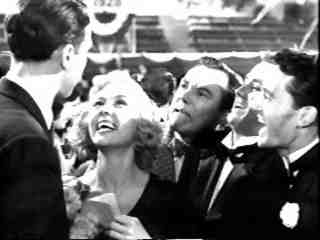
My wife, Gloria, heard about one man who tried to commit suicide and was given a videocassette of the film by his friends as a way of telling him, "Please don't - you've made a difference for good in our lives."
Many writers have referred to the part in which Clarence the Angel tells George, "Strange, isn't it? Each man's life touches so many other lives, and when he isn't around he leaves an awful hole, doesn't he?" As columnist Don Feder of the "Boston Herald" wrote: "In an increasingly impersonal world, this is an urgently needed message: that we count."
Frank died peacefully, in his sleep, last September 3 at his home in La Quinta, Calif. He was 94. I can't help thinking now that if Frank Capra had never lived, we would all be the poorer for not having his wonderful movie to celebrate every Christmas.
"What an idea!" I remember Frank saying when he first read the story on which his magnificent and enduring film is based. It's the kind of idea, he said, that people will remember and enjoy forever.
How right you were, Frank! How right you were.
==================================
Read an article written by Jimmy Stewart about his making of the movie, "It's A Wonderful Life," which appeared in GuidePost magazine.
Go Here:
Threats and Violent Attacks Against Muslims in the U.S., Just From This Week
Happy Holidays?






























